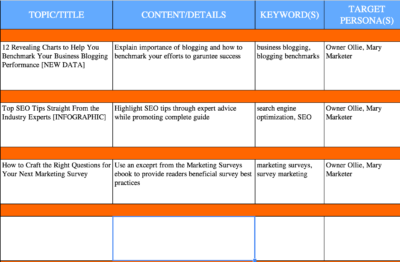Want to develop a fantastic content strategy? Aside from building customer profiles and mapping your content to their buying cycles, you’ll also need to equip yourself with excellent organisational skills and be prepared to do lots of planning. Content shouldn’t be published sporadically at a whim without any prior planning. You want your blogs, social media, eBooks or any other content you push out to be timely, relevant, well researched, and of course, well written.
Consider your editorial calendar as a roadmap for content creation, with guides on what sort of content to create, the topics you’ll cover, and which demographics you are trying to reach, and when to publish them to best support your inbound marketing strategy. You can create your own editorial calendar in four simple steps:

- Use a spreadsheet or calendar application to map out a general editorial plan. Depending on need, your content calendar should cover content for the next month or two, or even better, for the next three months.
- Identify your marketing goals and what you’re trying to achieve. Is your main concern increasing traffic? Raising awareness? Or do you want to position your brand as an industry leader? Each of these goals requires a different content strategy, but identifying them first allows you to work backwards to figure out how much content you’ll need to create, and on which platforms. For example, social media is a great way of raising awareness and reaching a very large, and general demographic. If you’re trying to position yourself as an industry leader, you may want to create content that is more informative such as eBooks and video tutorials.
- Include as much detail as possible in your content calendar. Mark down specific dates and fill them with specific tasks such as posting on social media, publishing blogs, making new videos. For each date, write down the topic name, the title of the piece and who you are targeting.
- Stay on top of all the different content you’re publishing by creating separate tabs for each type of content you publish, such as social media posts, blogs, eBook, etc. This way, your editorial calendar won’t look over-cluttered, and you can see clearly how each publishing platform can complement the others.


